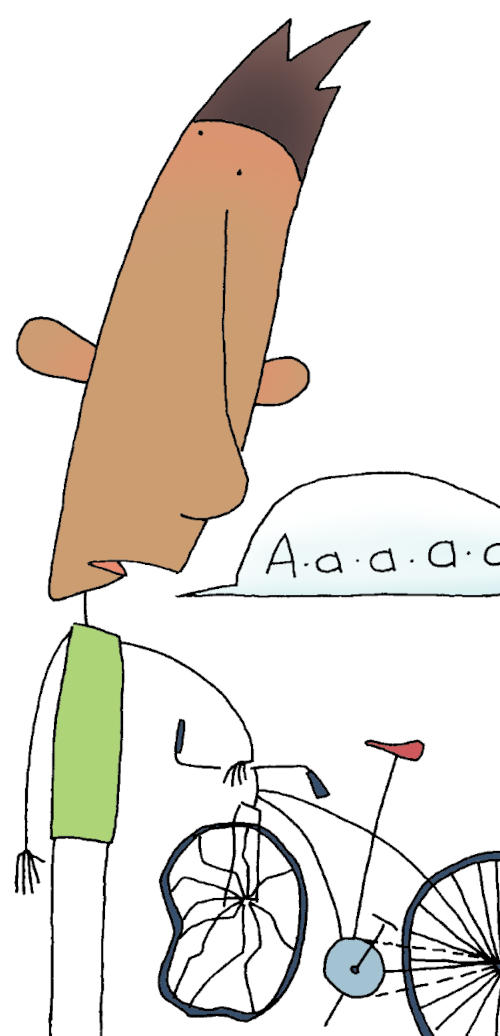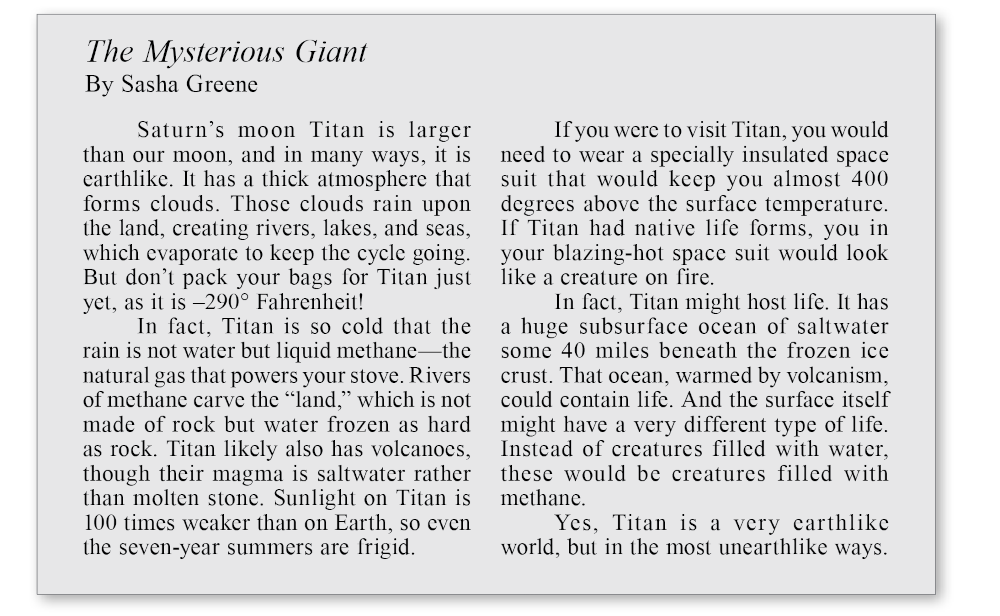WOC 292
Page 292
WOC 293

Page 293
Summarizing, Paraphrasing, and Quoting
“What happened?” asks your parent, pointing at the ruined front wheel of your bike. “Well, it’s a long story,” you reply. But your parent wants the short version, so you summarize.
Summarizing is taking a lot of information and boiling it down to its core ideas. In life, you may summarize events in response to a parent. In research, you summarize to tell readers about key ideas from a longer text.
Summarizing is an important research strategy, along with paraphrasing (putting other people’s ideas in your own words) and quoting (including someone else’s exact words). This chapter will help you decide which strategy to use and how to use it.
What’s Ahead
WOC 294
Page 294
Article and Summary
A summary captures the main point of a reading and provides the most important supporting details. Read the science article and the student summary that follows it.

Student Summary
Unearthlike Earth
The topic sentence names the article and author and provides the main point. In “The Mysterious Giant,” Sasha Greene describes Saturn’s moon Titan as earthlike but completely alien. Though the moon has a thick atmosphere, rain, and seas, the clouds rain liquid methane instead of water. Titan’s crust is water frozen to be rock hard. At –290° Fahrenheit, with sunlight 100 times weaker than on earth, Titan is in a deep freeze. Supporting sentences explain the topic sentence. It still might harbor life, whether in its saltwater sea 40 miles below the surface or in its methane lakes. Whatever life might exist would see a human visitor as a creature on fire. The closing sentence returns to the main point. Titan has many features that are similar to those on our planet, but the extreme cold makes it an alien world.
WOC 295
Page 295
Writing Guidelines
Prewriting ■ Planning Your Writing
Read through the selection once to get an overall understanding of it. Then reread the selection and write down the main point. Read one final time and note the most important supporting details.

Writing ■ Creating the Summary
Create a topic sentence that names the original source and expresses the main point in an interesting way. Then write a sentence or two for each important detail. Finish by writing a closing sentence that restates the main point.
Revising ■ and Editing ■ Improving the Writing
Use the following checklist to improve your summary.
_____ Ideas
- Do I identify the source and main point?
- Do I include only the most important details?
_____ Organization
- Do I have an effective topic sentence and closing sentence?
_____ Voice
- Does my voice fit the subject and purpose?
_____ Word Choice
- Have I correctly used terms from the original selection?
_____ Sentences
- Do my sentences read naturally?
_____ Conventions
- Have I checked my punctuation, capitalization, spelling, and grammar?
WOC 296
Page 296
Paraphrasing and Quoting
Paraphrasing is expressing someone else’s ideas in your own words. Quoting is providing the exact words of someone else. Either way, you need to credit your sources.
Paraphrasing
When you paraphrase, you restate the ideas in a source using your own words. Follow these steps:
- Read the part you want to paraphrase. Understand it as a whole.
- Paraphrase sections, not sentences. Put the main idea of the section in your own words, writing your own sentences to show your understanding.
- Check for fairness. Make sure your paraphrase reflects the writer’s original intention.
- Cite your sources. (See the “Helpful Hint” below.)
Quoting
Quote only passages that express an idea especially well, and then make sure you quote the exact words of the person. Follow these tips:
- Set off quotations. Use quotation marks correctly.
- Check the original. Make sure you have quoted exactly.
- Keep quotations short. Don’t allow them to overwhelm your own ideas.
- Introduce quotations and/or follow them with comments. Don’t just let a quotation hang there.
- Cite your sources. (See the “Helpful Hint” below.)
Helpful Hint
You cite sources to give credit to other thinkers. You also cite sources so the reader will know where you found your information. Here are three ways to cite sources:
Name the source and writer in the text.
In “The Mysterious Giant,” Sasha Greene describes Saturn’s moon Titan as earthlike but completely alien.
Use MLA parenthetical references and a works-cited page. (See pages 306 and 308–310.)
Though the moon has a thick atmosphere, rain, and seas, the clouds rain liquid methane instead of water (Greene).
If your work and your source are both online, provide a hyperlink.
The clouds rain liquid methane instead of water.